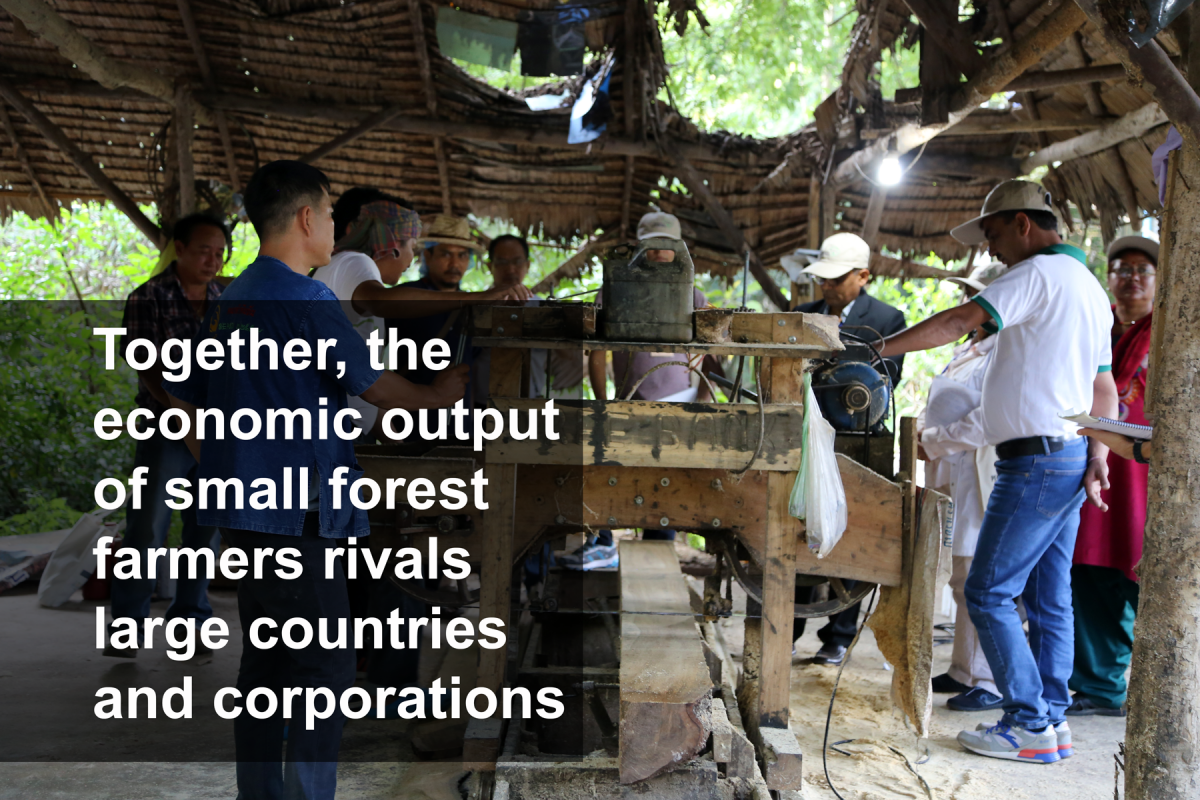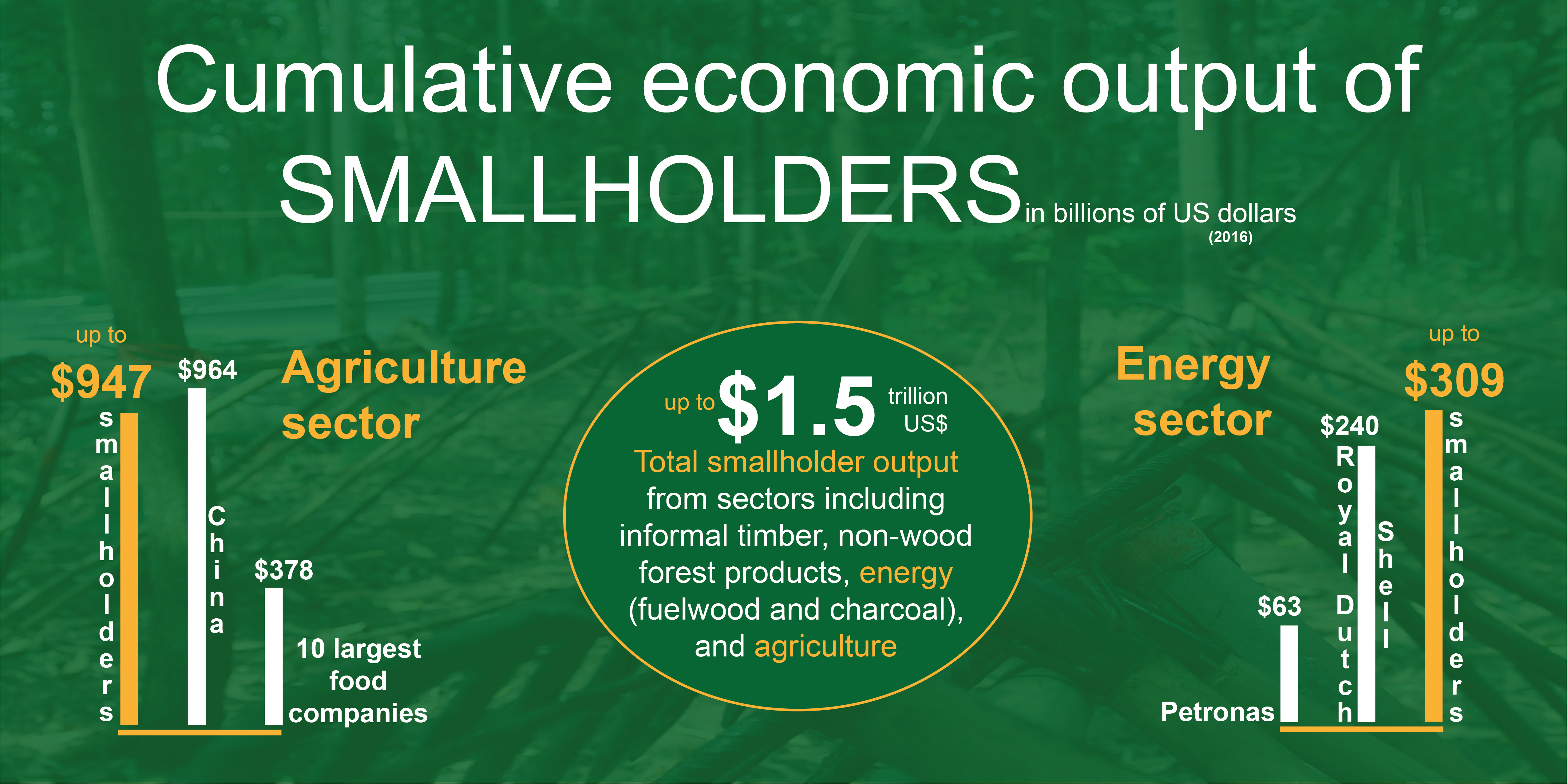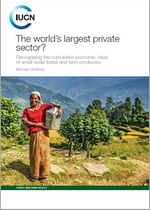A closer look at a collective economic giant: Small forest and farm producers - INTERVIEW
More than 1.5 billion small forest and farm producers throughout the world depend on forest landscapes to produce food, fuel, timber and non-wood forest products to meet their subsistence needs and generate cash income. Despite the large number of smallholders and the large collective scale of their production, policy makers have overlooked smallholders’ role as a powerful economic engine. A new publication sheds light on this gap in knowledge.

Photo: IUCN / Pauline Buffle
In spite of representing nearly a quarter of the world’s population, most of the economic value produced by smallholders is unaccounted for and unacknowledged by decision-makers, donors and other interested parties because of its small unit scale and unrecorded nature. As a result, the collective scale and economic importance of the smallholder forest and farm sectors are largely unknown.
A new publication commissioned by the Forest and Farm Facility (FFF) examines the collective output of smallholder forest and farm producers across the world – focusing specifically on the agriculture, energy, non-wood forest product, and informal timber sectors.
Jeffrey Campbell, of the Food and Agriculture Organization of the United Nations (FAO) and FFF Manager, shared some of his thoughts on what this new information provides.
What is a smallholder, and why is it important to consider their economic output?
A. We use the term smallholder in this context to describe small-scale producers of forest and farm products (focusing here on those who sell some proportion of their production), and enterprises which are established by or represent small scale producers. These may include a range of marketing, semi-processing and finished-product businesses at various stages of the value chain. We feel that the economic output of this range of economic actors has been undervalued and underappreciated. They are too often looked at as ‘poor’ and ‘needy’ – as the objects of development, not as vibrant producers of goods and services, both tangible and intangible which contribute directly to local, national and global economies in many ways – but also ensure the sustainable management of forests and farms – of livelihood landscapes. Much of the work and productivity of these producers and their organisations has remained in the so-called informal sectors, or has been undercounted for a range of reasons.
What inspired this publication? Was there a gap in the knowledge base?
A. The increasing focus on the private sector as critical actors in the new development agenda has often neglected the smaller-scale actors – the smallholders and small scale producers. Most private sector panels or representatives focus on the larger, often corporate sector – which is extremely important, but may only represent part of the true economic picture in the rural parts of most countries in the world.
While driving through the outskirts of major cities, small towns and along roads connecting rural regions with markets, I notice the dramatic density of small forest and agricultural product businesses – serving as outlets for the vast amounts of timber, fuelwood, charcoal, non-wood forest products, fruit, food, fodder, fibre, honey etc. from small scale primary producers. Each of these processing units are themselves employing a number of people, and in turn supplying large value chains. A large proportion goes uncounted.
This inspired the FFF partners and a number of like-minded organisations to try and put together a better picture of the true collective dimensions of this small-scale sector. In the process, it was clear that there are very large gaps in the knowledge base. These gaps are partly a result of the informal nature of the sector – the lack of clear tenure and use rights for forests, collective and community land, and even for much farm land – and of rules and regulations which may inhibit formal reporting or trade. Ongoing lack of clarity on the definitions of who is or isn’t a small scale producer, a micro or small and medium scale entrepreneur, and the lack of understanding of many of the value chains, all contribute to a paucity of available information. Lack of good geo-referenced data: disaggregated by scale of enterprise, gender of the producers and entrepreneurs, the variety of products produced and traded, and turnover make it difficult to find data.
 Photo: IUCN / Corbett Nash
Photo: IUCN / Corbett Nash
Were you surprised by the findings? Why?
A. I was impressed by the indications from this preliminary study that we are on the right track in assuming that the aggregate dimensions of the small scale are bigger than assumed or than people acknowledged. It was also surprising to find out how difficult it is to put together some of these estimates. However, being able to say that the turnover of the wood fuel sector – which FAO Forest Resource Assessments showed constitutes almost 49% of removals from the world’s forests and is mostly in the hands of small scale producers and traders – is at a comparable level to the largest energy producing corporations is pretty impressive and will hopefully ensure a stronger presence of this ‘hidden’ sector. This can then help to develop more sustainable production and consumption patterns.
Now that we have some initial global estimates of collective smallholder output, what can we do with this information?
A. The first thing is the realisation that we need much more and better data. For instance, we still don’t have good estimates of smallholder and small scale production of timber, not to mention non-wood forest products, medicinal plants etc. These are needed at the national level so incentives, policies and priorities for support can be redirected to the large ‘small-scale’ sector; and also at global levels to influence investment and the flow of capital down to the level that is closest to the resources to ensure sustainability over time.
The second thing we can do is use what we now know to move the discussion about the private sector to a more nuanced and balanced one, which looks more clearly at small scale actors – who collectively, are many, and who may be contributing much more to poverty alleviation, food security and nutrition and climate change resilience than any other actors. We can use this information to argue for more support to strengthening the capacity of forest and farm producer organisations to contribute even more fully the Sustainable Development Goals agenda, the Paris Agreement and improvement of well-being worldwide.
We at the FFF, drawing on the strengths of our partners and leading apex forest and farm producer organisations around the world, have an implementing mechanism in place to build this capacity and strengthen the organisation of these small producers to make them more visible as true agents of change.
The Forest and Farm Facility (FFF) provides support to forest and farm producer organizations (smallholders, rural women’s groups, local communities and indigenous peoples’ institutions) to increase their technical and business capacities to play their precious role for fighting against climate change and improving food security. FFF also engages with government to develop cross-sectoral mechanisms and policy processes which make use of rural people’s input. FFF is a partnership between FAO, IIED and IUCN, and AgriCord. http://www.fao.org/partnerships/forest-farm-facility/en/




